Dance, when you’re broken open. Dance, if you’ve torn the bandage off. Dance in the middle of the fighting. Dance in your blood. Dance when you’re perfectly free.
—RUMI
I’ve never met a dancer who wasn’t super flexible, but just like the rest of us, they didn’t start that way! They work at it, and work at it hard, practicing their flexibility each and every day. When I was a professional dancer, I always made sure to cool down and stretch properly after every rehearsal and performance. In all my years, I never sustained a serious injury, and I strongly believe that my diligent flexibility routine was a big part of that enduring health.
Most people are very tight in certain areas of their bodies, especially the hips, neck, and back. This is usually due to a lot of sitting, either at a desk for work, driving in a car, or kicking back on the couch, relaxing. If you’ve had an injury in the past, you might also notice that you have tightness there or in the surrounding area, which is usually due to a buildup of scar tissue around the site of the injury. As we age, many of us will also experience arthritis, which causes pain and stiffness in hips, knees, and back.
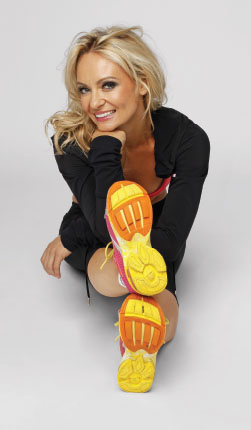
Fortunately, flexibility is something you can regain with patience, time, and consistent effort. Becoming more flexible has so many benefits—from alleviating pain to preventing injury to increasing your range of motion and enabling you to move with ease, both in exercise and everyday living.
Stretching is also an important part of recovery—it’s like a little detox session to clear your mind and clean out your system. Gentle stretching allows your muscle fibers to release and flush out built-up lactic acid—a metabolic waste product of exercise that can get trapped in cells and cause stiffness and soreness. Breathing deeply as you stretch also helps you relax physically and mentally, and delivers oxygen to your tissues, which can improve circulation and accelerate the time it takes you to rebound from a workout. A post-workout stretch also helps you mentally transition back into your day. When I stretch, I like to focus on specific muscles, consciously asking them to relax and elongate and thanking them for a job well done. It’s a really great way to connect with my body on a different level.
After every BBS workout you should spend at least 10–15 minutes stretching. For every stretch you want to go to the limit of your range of motion—which can be a little uncomfortable—but not push yourself to the point of pain. Hold the stretch at that sweet spot of resistance for 30–60 seconds, slowly relaxing and increasing your stretch while inhaling and exhaling deeply. There’s no bouncing here—only slow, deep stretches that lengthen and release your muscles, better allowing them to recover and be ready for your next workout.
Everyone has a different level of flexibility and the tightness of our muscles is impacted by the other activities we do. For example, if you jog or run regularly, you might have tight hips and hamstrings, so spend a little extra time working on them. Or if you enjoy cycling, your quadriceps might need some TLC. Whichever areas feel the stiffest or sorest are the ones you should give the most love. The more time you devote to your flexibility routine, the more results you will see. It’s a good idea to note your improvements in your journal as you go along so you can track your progress. Maybe you were barely able to touch your toes initially, but after 6 weeks you can place your palms on the floor in front of you. That’s a major accomplishment—write it down!
The Stretches: All Levels
Time: 10–15 minutes
A dancer’s body is her computer, her office, her only tool for work, and she must take care of it both onstage and off. Do this stretching routine after every BBS workout to properly nurture your body, helping it recover, progress, and grow.
Standing Side Stretch
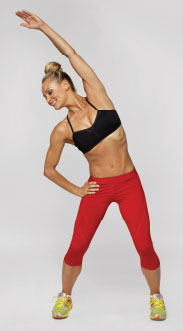
Stretches: obliques, shoulders
Stand with your feet hip-width apart. Place your left arm on your left hip and reach your right arm overhead, stretching it diagonally toward the left side of the room as you bend at the waist. Hold for a few moments, or until you feel the stretch in you obliques. Repeat on your left side.
TIP: Make sure to keep your hips square: try to avoid twisting them to one side or the other.
Q&A
QUESTION: Can I stretch before I work out instead of after?
ANSWER: Yes, but with this caveat: do the stretches described in this chapter at the end of your session. These are called “static” stretches and are designed to lengthen and relax your muscles, increase your range of motion, and improve flexibility. You don’t want your muscles to be too relaxed when you’re getting ready to exercise, so if you want to stretch beforehand, do more “dynamic” stretches, movements that simultaneously warm you up and improve your range of motion, such as twisting side to side, swinging your arms or legs, and moving your limbs around in all directions to loosen up and get them ready to work. You never want to stretch a cold muscle, so dynamic stretching is perfect for pre-workout flexibility.
QUESTION: Back when I used to dance we were told to bounce when we stretched to make our muscles stretch farther. Is that still okay?
ANSWER: That sort of “ballistic” stretching is no longer recommended. Ballistic stretches force your muscles to stretch beyond their natural capacity, which can cause tearing and straining, especially if a muscle is cold. Static stretching, as described in this chapter, has replaced ballistic stretching for post-workout flexibility training. Through slow, gentle release and deep breathing, your muscles stretch safely and effectively to improve your range of motion and accelerate recovery time.
QUESTION: My right hamstring is a lot tighter than my left, but I have never had an injury. What gives, and how can I make both legs even?
ANSWER: It’s pretty normal to be tighter on one side than another. Whether you favor one side while you sit without realizing it, or are simply built a little off kilter (most people are not perfectly symmetrical!), this is totally normal. No one’s body is perfect, but you can work to bring both sides into balance. Spend a little extra time on the parts that are tightest and need more attention.
Standing Calf Stretch
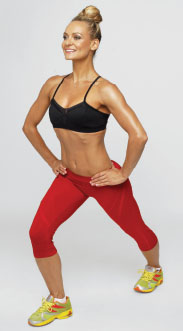
Stretches: calves, ankles
Stand with your feet apart in a wide lunge, with your back leg straight and your front knee bent. Press your rear heel toward the floor and hold. You can place your hands on your hips or hold on to a wall for balance if need be. Hold 30–60 seconds.
TIP: Slowly bend and straighten your rear knee, rolling up onto your toe, then pressing your heel back down again to stretch your foot, ankle, and calf.
Standing Quad Stretch
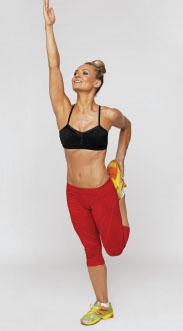
Stretches: Quadriceps
Stand with your feet hip-width apart. Bend your right knee and bring your heel toward your glute. Grab the toe of your shoe with your right hand and hold. You can place your left hand on a wall or a sturdy chair for balance if need be. Hold 30–60 seconds; repeat with left leg.
TIP: Make sure your bent knee is pointing straight down toward the floor; don’t let it flare out to the side. Also make sure you’re not overarching your back. Keep your pelvis tucked underneath you to keep your spine safe.
Chest and Shoulder Stretch
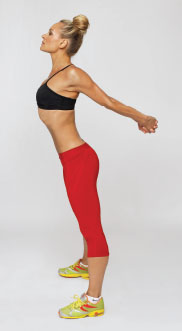
Stretches: pectorals, front deltoids, rotator cuffs, biceps
Stand with your feet hip-width apart and reach both arms behind you. Lace your fingers together and straighten your arms. Keep your chest lifted and press your shoulders down away from your ears. Hold 30–60 seconds.
TIP: If you can’t lace your fingers together, hold a rolled-up magazine behind you with your hands as close together as you can get them. As you stretch, try to slowly “walk” your hands in toward each other to deepen the stretch.
Cat/Cow
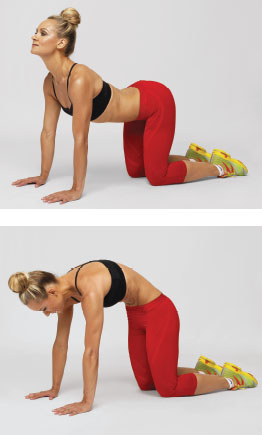
Stretches: abdominals, hip flexors, back, neck
Start on your hands and knees—in tabletop position. Lift your chin and look up, dropping your belly toward the floor, arching your back, and lifting your tailbone to the sky to make the cow position [1]. Hold here for several breaths, then drop your head, round your back and tuck your tailbone under to make the cat [2]. Continue, alternating slowly between the two for 60 seconds.
TIP: Imagine your spine as a whip of licorice—bendy and soft and flexible!
Downward Dog
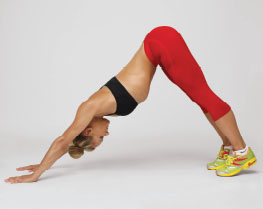
Stretches: calves, hamstrings, glutes, shoulders, upper back, chest, neck
Start in plank position with your hands directly underneath your shoulders and your head, hips, and heels in line. Lift your hips up toward the ceiling and shift your weight back, dropping your heels toward the floor and your head between your hands. Your arms and legs should be straight and your body should make an inverted V. Hold for 60 seconds.
TIP: Breathe deeply, and sink into your heels with each breath, and lift your tailbone on each exhale. You can also spread your fingers wide on the ground for better balance.
Cobra
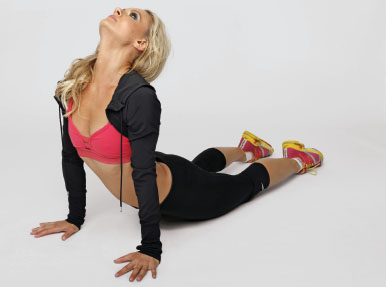
Stretches: lower back, abdominals
Lie facedown on the floor with your legs straight. Place your hands on the floor at shoulder level and, pressing down into the floor with your palms, slowly push your upper body up from the floor, pressing your hipbones toward the floor and lifting the abdominal muscles toward your spine.
TIP: Don’t let your shoulders creep up to your ears. Push them down and away as you stretch, relaxing the shoulder blades to avoiding creating tension in the back and shoulders.
Seated Hamstring Stretch

Stretches: hamstrings
Sit on the floor with your legs extended in front of you. Fold your left leg in toward your pelvis, keeping your right leg straight and both hips on the floor. Reach your hands forward toward your right foot and slowly fold your body over your right leg, reaching as far toward your toes as you can while keeping your left hip on the floor. Switch legs and repeat.
TIP: Don’t worry about being able to touch your toes right away, just reach as far as you can! Also remember to try to maintain a flat back, even though it’s tempting to hunch over.
Stretching Playlist
I love to use music to relax and wind down from my workout. Here’s a playlist I suggest to do just that.
“Sparks,” by Coldplay
“Wonderwall,” by Ryan Adams
“Teardrop,” by Massive Attack
“Falling Slowly,” by Glen Hansard & Marketa Irglova
“Hallelujah,” by Jeff Buckley
“Let It Be Me,” by Ray LaMontagne
“More Than Words,” by Extreme
“Ordinary People,” by John Legend
“Gavin’s Song,” by Marc Broussard
“Burn for You,” by John Farnham
The Plan
Suggested Stretching Routine
